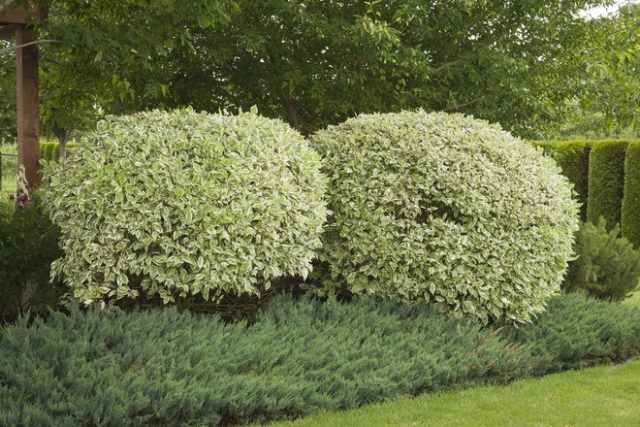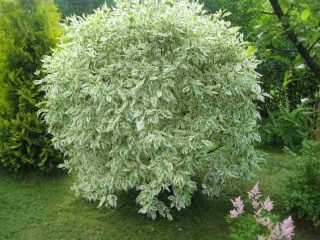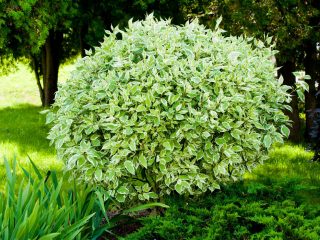Content
- 1 Description of the white tree Elegantissima
- 2 Differences between white Sibirika Variegata and Elegantissima
- 3 Derain Elegantissima in landscape design
- 4 Planting and care of white Elegantissima tree
- 5 Height of the white Elegantissima tree
- 6 Reproduction of the white Elegantissima tree
- 7 Diseases and pests
- 8 Conclusion
White dogwood Elegantissima is an ornamental hardy shrub of the Dogwood family, one of the most popular varieties of white dogwood. Among other garden crops, this plant is distinguished by its high decorativeness and undemanding nature. In addition, white derain Elegantissima is one of the most frost-resistant varieties of the species, which makes it possible to grow this shrub even in the Northern regions of Russia - it safely tolerates low temperatures and does not need shelter for the winter.
Description of the white tree Elegantissima
White dogwood Elegantissima (in Latin - cornus alba elegantissima) is so called for the elegant appearance and color of its flowers and fruits - they are painted white. In addition, the leaf plate has a light edging.
The height of an adult plant is 2.5-3 m, diameter - 3 m. The shrub is spreading and quickly grows to the sides.
The color of the Elegantissima tree shoots varies from brown to rich red, thanks to which the bushes decorate the garden even in winter, when there is a shortage of bright colors. Young shoots are paler - they first have an olive color, and only by autumn the bark acquires a reddish tint.
The shape of the leaf plate is represented by an oval, pointed on one side. The surface of the leaf is slightly corrugated, the color is grayish-green. The bottom of the leaf blade is light gray. With the onset of autumn, the color of the foliage does not change.
The first flowering occurs 3 years after planting. Then the Elegantissima derain blooms twice a year - in late May-early June, and in September. The flowers of the variety form dense inflorescences.
The lifespan of the Elegantissima variety is 50-60 years.
The photo below shows a young Elegantissima white derena bush formed in the shape of a ball.
Differences between white Sibirika Variegata and Elegantissima
The varieties of white wood Elegantissima and Sibirika Variegata are similar in many ways, but there are also a number of significant differences between them:
- The Sibirika Variegata variety is slightly lower - the height of an adult plant is only 2 m, while the Elegantissima variety reaches 3 m in height after 10 years.
- The diameter of the plant is also smaller - about 2 m.
- The leaf color is dark green. The foliage of the white Elegantissima variety is lighter.
- The surface of the leaf blade of the Sibirika Variegata variety is often covered with cream-colored spots or stripes.
- In autumn, the leaves of the Sibirika Variegata tree acquire a pinkish-purple hue.White Derain Elegantissima does not change its color.
- The flowers of the Elegantissima variety are white. The Sibirika Variegata variety has cream flowers with a greenish tint.
- Sibirika Variegata grows more slowly than its counterpart and does not form shoots as actively.
- Derain Elegantissima bears fruit abundantly with proper care. The Sibirika Variegata variety bears fruit more modestly.
Derain Elegantissima in landscape design
The leading characteristics of the Elegantissima white tree variety are the unpretentiousness of this garden crop and the high degree of decorativeness, which is ensured by the bright color of young branches and the unusual color of the leaves. These qualities have earned the shrub great popularity in the field of landscape design - derain is used both in single plantings and in group compositions. A special advantage is the ease of forming the crown of the plant.
How to form a tree from Elegantissima wood
The decorative quality of the Elegantissima tree is quickly lost in the absence of periodic pruning. In order to maintain the attractive appearance of the bush, it is necessary to pinch it with your hands or trim the shoots with garden shears.
Since the variety is capable of growing strongly in the shortest possible time, the shrub can be formed into almost any shape:
- To give the tree the appearance of a column, it is necessary to remove first of all the side shoots. The central strong branches are left. It is important not to make the column too narrow - if you remove too many branches, the plant may fall under the influence of strong winds.
- The formation of an arch from Elegantissima wood is very popular.To do this, the bush is attached to a special arched structure, tying the ends of the shoots to it.
- The hemisphere is another popular figure made of wood. This form is formed by pruning one-year and three-year-old branches in autumn or spring at a level of 10 cm from ground level. As a result, active growth of young shoots begins. In this way, the plant is also rejuvenated and made more decorative, since young shoots have a rich red tint.
White Elegantissima wood also forms full-fledged balls and cubes. The variety of shapes is almost unlimited, and every subsequent year you can try new shapes - this does not harm the bush in any way.
Elegantissima tree hedge
Forming a hedge from the white Elegantissima variety of wood is impossible without timely pruning. The shrub quickly forms new shoots, and if they are not removed, the plantings will become overgrown.
In order to maintain the decorative appearance of a turf fence, it is necessary to regularly remove shoots that are too prominent and dried out or broken throughout the year. Deeper pruning is carried out in August or September.
Planting and care of white Elegantissima tree
Even a novice gardener can plant and subsequently care for the Elegantissima white dogwood variety. This shrub is hardy and undemanding. In order to achieve abundant flowering and rapid growth of the crop, you just need to choose the right place to plant the plant and follow a number of simple rules for caring for it.
White Elegantissima derain develops best in open, illuminated areas. Shade inhibits the growth of shrubs, however, planting in partial shade is quite possible.
The advantage of the variety is its immunity to groundwater levels. As for the composition of the soil, it is better to give preference to moist, fertile areas. However, with periodic feeding white derain Grows well in poor soils.
The shrub develops worst of all on sandy and clay soils. Heavy soil makes it difficult for oxygen to reach the roots of the plant, which greatly affects its growth.
Landing dates
The timing of planting white Elegantissima tree depends on the method of propagation. For example, freshly harvested seeds are sown in the fall, while stratified planting material is sown in the spring. Also in the spring months, cuttings of white deer are planted. Layers are replanted in the fall.
Landing rules
The algorithm for planting white Elegantissima tree is as follows:
- 15 days before planting, the area is prepared. To do this, dig up the selected place and add mineral fertilizers, compost and humus to the soil. With such preparation of the site, the bushes subsequently need not be fed for several years.
- The size of the planting hole should be much larger than the earthen ball of the seedling.
- Fertilizers are placed at the bottom of the pit: mineral additives and humus.
- Before placing the seedling in the hole, it is watered. After 10 minutes it can be transplanted.In this case, the integrity of the earthen clod must not be violated.
- The derain is carefully sprinkled with soil, lightly compacting the area near the trunk.
- Immediately after planting, water the plant.
Watering and fertilizing
White dogwood Elegantissima is watered infrequently. The main thing is that the soil under the bush does not dry out. Recommended dosage is 2 buckets per plant.
It is not necessary to feed the Elegantissima variety - the plant is undemanding to the level of soil fertility. It is enough to fertilize the area 2 weeks before planting and place a layer of nutritious soil mixture at the bottom of the planting hole. This plant will last for 2-3 years, but even if the place was not properly prepared before planting the tree, the bushes are fed only in case of illness or after pruning errors that have weakened the tree. You can also fertilize the soil under young seedlings with humus.
Complex mineral fertilizing is carried out every 3 years. You can dilute them with wood ash. In July, sometimes the bushes are fed with peat or compost, but this is not necessary. White dogwood does not need a large amount of organic matter - about 100 g is enough.
Pruning Elegantissima tree
The first pruning of the Elegantissima variety is done 3 years after planting. To do this, remove 1/3 of all shoots. First of all, cut off broken and old branches.
White Elegantissima can be trimmed at any time of the year.The only exception is the period of time when the juice begins to flow actively.
Depending on the time of trimming, the result will vary slightly. When forming a plant in the spring, the shoots are removed almost at the root - only stumps up to 20 cm are left. Afterwards, the set of green mass of the bush will improve to the detriment of flowering and fruiting.
In autumn, the Elegantissima variety is pruned to form a tall bush with a large number of flowers. To do this, remove 3-4 leading shoots.
Old plants are cut out almost at the root every 3-4 years.
You can learn more about the features of planting white Elegantissima tree and caring for it from the video below:
Preparing for winter
The white Elegantissima variety does not need shelter for the winter - this shrub is able to withstand very low temperatures without harm to development. Even if it freezes, the plant quickly recovers.
Only young plants are covered in the first year after planting in open ground. There is no need to cover the bushes in the future.
Height of the white Elegantissima tree
The height of an adult white cornus alba elegantissima tree reaches 3 m. This is a relatively short variety when compared with other varieties.
The growth of the bush per year is 40-60 cm. The plant develops especially actively in the summer months.
Reproduction of the white Elegantissima tree
White elegantissima dogwood is propagated in the following ways:
- cuttings (both green and woody);
- layering;
- seed method.
The most popular propagation of shrubs is through layering.
Propagation of Elegantissima tree by cuttings
Most often, when propagating a crop by cuttings, preference is given to lignified cuttings, since green specimens do not take root well. It is recommended to combine the process of preparing cuttings with pruning in the spring.
The cutting procedure is as follows:
- In the spring, the healthiest and strongest bush is selected and part of the shoot is cut off from it.
- The resulting cut is checked for suitability. To do this, you need to bend it slightly. An unsuitable cutting will either break or be unable to return to its original position. If the cut section of the shoot straightens after bending, it can be used to propagate the bush.
- Selected cuttings are planted in boxes filled with a mixture of sand and humus soil. It is important to deepen them at an angle of 45°. Before planting, the soil is slightly moistened.
- After planting the material, the containers are moved to the greenhouse. The optimal temperature for normal development of cuttings is 20-35°C.
- Planting material is regularly sprayed, maintaining light soil moisture.
- In the fall, when the cuttings have formed a full-fledged root system, they are transplanted to a permanent place.
- In the first winter, the young plant is covered with spruce branches. In subsequent years there is no need for shelter.
By layering
Reproduction by layering is so popular due to its simplicity. In order to propagate white Elegantissima turf in this way, you must follow the following scheme:
- In spring, bend one of the young shoots of the bush to the ground.
- Slightly bury it in the soil. Recommended depth is 10-12 cm.
- Secure the branch so that it does not unbend.
- The buried shoot is regularly watered moderately.
- In autumn, the branch forms fairly developed roots. The young plant can be transplanted to another area.
Seeds
Planting material for propagation by seeds is collected in the fall. Then you can plant the seeds in open ground, deepening them no more than 5 cm. Stratified seeds are sown in the spring.
The variety grows quite slowly, so the first shoots will appear only in the 3rd year of the seedling’s life. The plant will reach a height of 3 m only 10 years after planting. It is precisely because of such a long development that this method of reproduction is practiced so rarely.
Diseases and pests
White dogwood Elegantissima rarely gets sick, however, this only applies to mature plants. Young bushes have weak resistance to various fungal diseases. Particularly worth highlighting is powdery mildew, which often affects shrubs in the first few years after planting.
The first signs of infection are whitish spots that appear first on the lower branches and leaves. These spots spread very quickly throughout the plant and nullify its decorative value. If the disease starts, transparent drops appear on the spots, which formed the basis for the name of the fungus. Ultimately, the infection dries out the bush, which leads to the cessation of flowering and the rapid death of the plant.
The development of the disease is provoked by drying out of the soil, thickening of plantings and excess nitrogen content in the soil.
To combat the fungus, gentle folk remedies are mainly used:
- garlic decoction;
- horsetail decoction;
- soap solution;
- a solution of baking soda and soap.
You can also use any fungicide from the store.
Insects attack the Elegantissima variety infrequently. Aphids are considered the most dangerous pest, however, they can easily be controlled with conventional insecticides. A solution of laundry soap also works well to repel aphids. Some time after treating the bushes with soapy water, they must be cleaned of plaque with a weak stream from a hose.
Conclusion
White dogwood Elegantissima is a garden crop that can decorate a garden not only in summer, but also in winter. The main advantages of the shrub are hardiness, high decorativeness and frost resistance, which allows it to be successfully grown in almost all regions of Russia. In addition, this variety is extremely unpretentious, and caring for it will not be difficult.






















Can it be planted at the end of October?